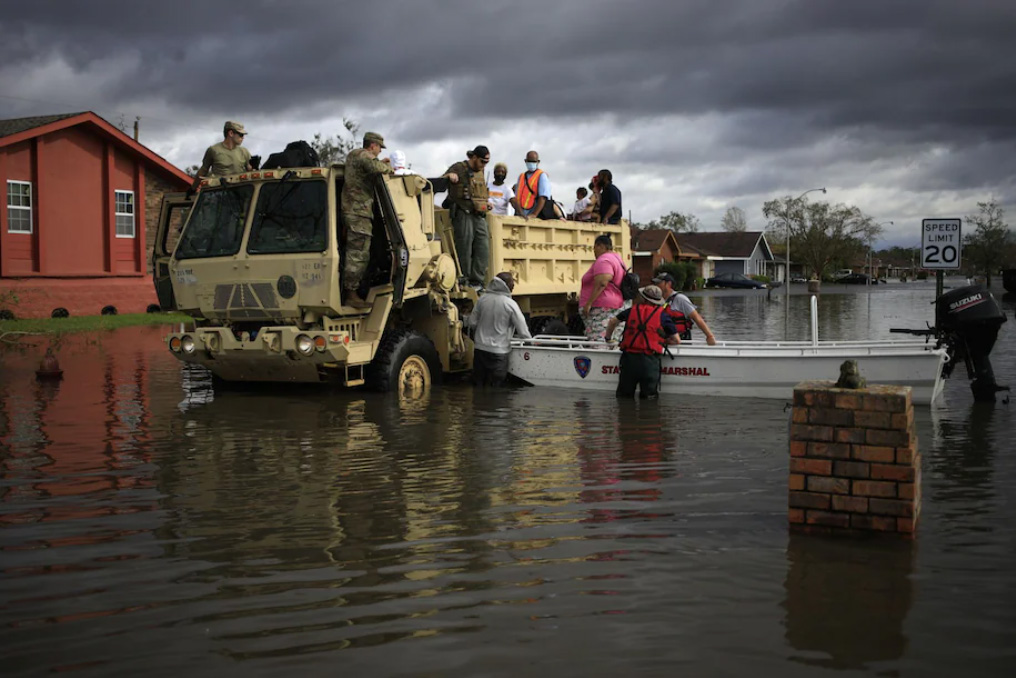
Climate change will cause the nation’s flooding losses to jump more than 26 percent over the next three decades, with disadvantaged communities shouldering an outsize share of the economic burden, a study published Monday predicted.
Researchers at the University of Bristol in Britain used data from flood insurance claims, building records, the census and other sources to forecast how a warming planet will affect flooding patterns across the United States, and pinpoint which communities might see the most change.
The study, published in the journal Nature Climate Change, estimates that the annual cost of flooding in the United States will increase 26.4 percent — from $32.1 billion to $40.6 billion — by 2050. But the forecast assumes nations will reduce planet-warming emissions roughly in line with the targets agreed upon at the recent COP26 climate summit. If those targets aren’t met, the costs could be even greater.
It’s the latest scientific research to show the myriad ways in which rising temperatures associated with climate change could reshape society, destroy homes and infrastructure, and endanger lives.
A 2021 study from German researchers predicts that the occurrence and intensity of extreme flood events will grow as global temperatures rise. A U.N. study last year warned of “profound consequences” for people and nature alike if the crisis is not brought under control.
The new study also is in line with other research to suggest underrepresented groups will disproportionately feel the effects of climate change. The Environmental Protection Agency has said members of minority groups will incur more deaths from extreme heat as well as more flooding-related property losses.
The most-pronounced flood risk now rests with impoverished White communities, the Bristol study concluded. But their findings suggest Black communities will see their flooding costs increase twice as quickly moving forward, largely for geographic reasons.
The southeastern United States, which is home to large Black populations, is expected to experience more hurricanes as temperatures continue to rise. Flooding costs are expected to increase 49 percent in Jackson, Miss., for example, and 24 percent in far-inland Montgomery, Ala., according to an interactive map the authors published on the academic news site the Conversation.
“Poorer, Whiter communities bear that historical flood risk, but the people that are bearing a disproportionate burden of those new risks are typically Black communities across the Southeast,” said Oliver Wing, a research fellow with the school of geographical sciences at University of Bristol, who was the study’s lead author.
The sharpest cost increases are projected to occur in the Southeast, along the Gulf and Atlantic coasts.
Flood damages are expected to spike 372 percent in Cameron County, on the southernmost tip of Texas. In Miami-Dade County, Fla., the forecast is 50.9 percent. Several southern Louisiana counties could see tenfold jumps.
But the forecast also points to possible hot spots far inland, in mountainous areas like Teton County, Wyo., and Grant County, Wash., where costs are expected to jump 20.5 and 23.8 percent respectively. Comparatively low-lying Albemarle County, Va., home to Charlottesville, is expected to see its flooding costs increase by about a third.
Meanwhile, other areas in the middle of the country could be little changed, and some could experience fewer floods as they become more dry.
In a teleconference Monday, two of the study’s authors said their research highlights how zoning boards, mortgage lenders and developers ― any entity with sway over where things get built ― need to do a better job of considering flood risk in their assessments. That includes whether a particular plot might become a flood plain over the course of a 30-year mortgage.
The estimated $32.1 billion in 2020 flood damage is not just a benchmark to measure climate-related devastation, the authors said; it’s also a measure of how the existing property development system already fails to protect people from disasters.
“Our planning system doesn’t sufficiently screen out risky development,” said Paul Bates, a Bristol hydrologist who studies the science of flooding.
As the population grows and the Earth continues to warm, protecting lives and property might require a rethinking of where we build and where we live. “Humans have generally settled around rivers,” Wing said. “But that doesn’t take away from the fact that they can be fundamentally dangerous places to live.”
Inland flooding events cost more than any other severe weather event. Such disasters been the leading cause of death associated with tropical cyclones, according to the Federal Emergency Management Agency. Last year in the rural riverside community of Waverly, Tenn., for example, flash-flooding caused by torrential downpours killed 21 people as places not considered floodplains were submerged.
The White House has said it will work to revise building standards for flood-prone communities nationwide, as well as launch new tools to make climate information more accessible to the public. FEMA has been exploring how it could update flood plain management standards, which have been largely unchanged in more than four decades.
The authors said flood costs will grow even if governments around the globe are able to dramatically decarbonize the environment starting immediately.
“These impacts are so near-term that climate mitigation (that is, decarbonization) is futile, meaning we can only adapt to this increasing risk in areas currently developed,” the authors wrote. “We thus have to adapt to both the now and the future.”